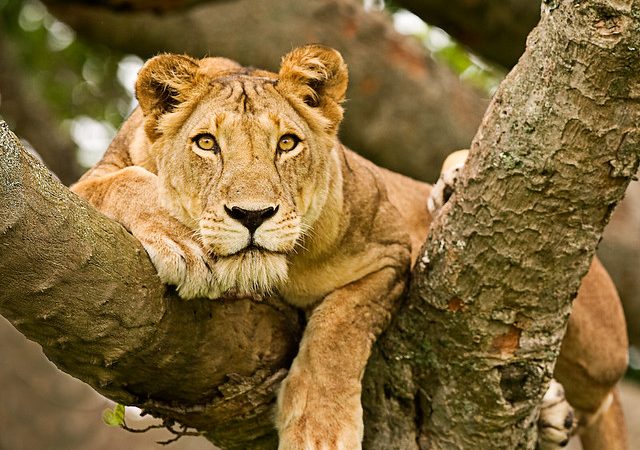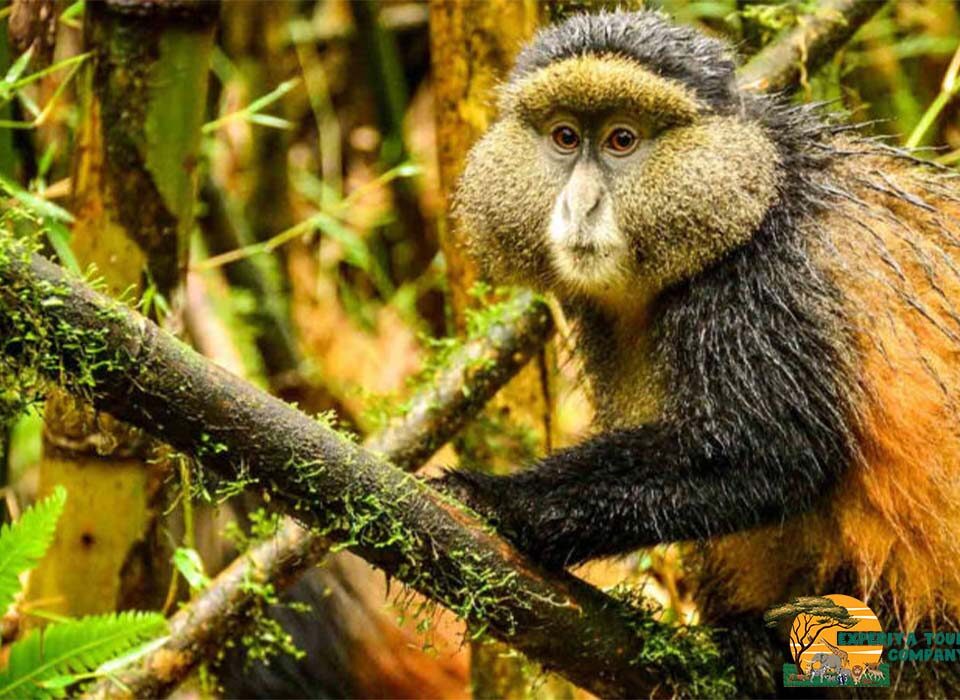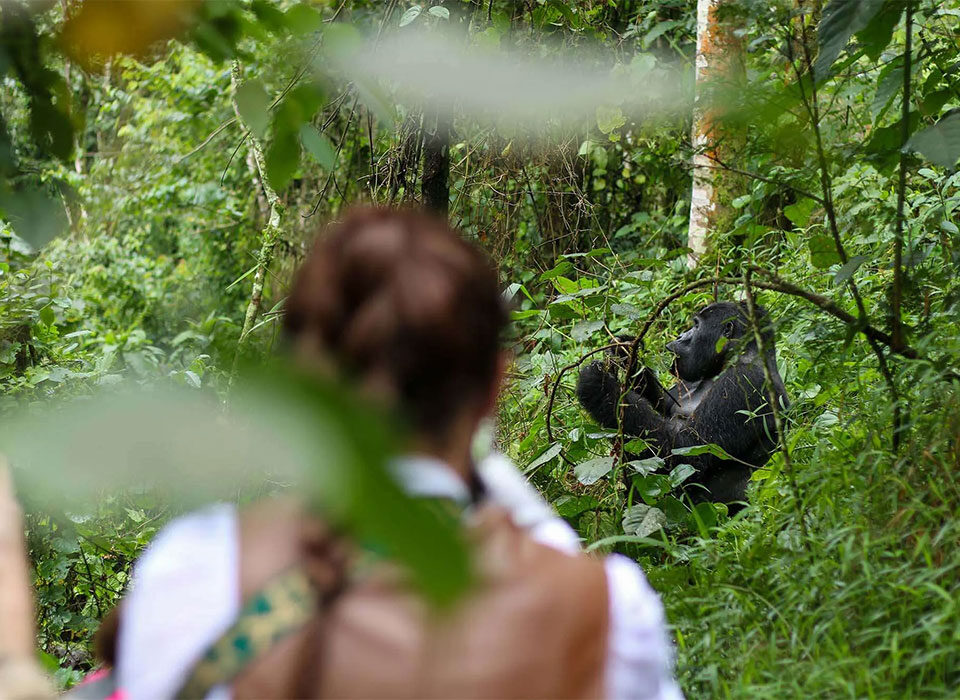
What Animals Can I See in Queen Elizabeth National Park? | Uganda Safari Guide by Experiya Tour Company
October 23, 2025
Can I Go on a Boat Cruise Along the Kazinga Channel? | Uganda Safari Guide by Experiya Tour Company
October 23, 2025What’s Special About the Tree-Climbing Lions of Ishasha? | Uganda Safari Guide by Experiya Tour Company

What’s Special About the Tree-Climbing Lions of Ishasha?
Hidden in the wild southern reaches of Queen Elizabeth National Park lies one of Africa’s most extraordinary wildlife spectacles — the tree-climbing lions of Ishasha. These majestic big cats, famous for their rare and mysterious behavior of resting in trees, have made the Ishasha Sector one of Uganda’s most sought-after safari destinations. Here, amid endless fig and acacia trees, you can witness a sight few places on Earth can offer: full-grown lions lounging high in the branches, tails dangling lazily as they survey the open plains below.
But what makes these lions so special? Why do they climb trees when most lions elsewhere prefer the ground? And what can you expect when visiting Ishasha to see them?
In this detailed guide, we’ll uncover the secrets behind the tree-climbing lions of Ishasha — exploring their behavior, habitat, and importance to Uganda’s tourism. We’ll also explain how to plan your visit and why traveling with Experiya Tour Company ensures you enjoy the most unforgettable and seamless experience possible.
Where Is Ishasha Located?
The Ishasha Sector lies in the southern part of Queen Elizabeth National Park, about 120 kilometers from the park’s main Mweya Peninsula and roughly 470 kilometers southwest of Uganda’s capital, Kampala. It’s also conveniently located along the route that connects Queen Elizabeth National Park to Bwindi Impenetrable National Park, making it a popular stopover for travelers heading to trek mountain gorillas.
The landscape here is breathtaking — vast golden savannahs dotted with fig and acacia trees, fringed by the Ishasha River that marks the border between Uganda and the Democratic Republic of Congo. The area is quieter and less crowded than the northern parts of the park, offering a true sense of wilderness and exclusivity.
The Unique Behavior of Tree-Climbing Lions
In most of Africa, lions spend their time on the ground, usually lying in the shade or hidden in tall grass during the heat of the day. However, in Ishasha, entire prides have developed the remarkable habit of climbing and resting in trees — particularly fig trees and acacias with wide, sturdy branches.
Watching these large predators perched gracefully among the branches is both surreal and mesmerizing. You might see a dominant male lion sprawled across a tree limb with his golden mane glistening in the sunlight, or a group of lionesses lounging together, occasionally yawning or adjusting their position as they keep watch over the plains below.
This behavior is not only fascinating but also rare. While some tree-climbing lions are found in Tanzania’s Lake Manyara National Park, the phenomenon is much more consistent and observable in Ishasha, making Uganda one of the best places in the world to witness it.
Why Do Lions in Ishasha Climb Trees?
Scientists and wildlife experts have long debated the reasons behind this unusual behavior. There’s no single proven explanation, but several theories help us understand why the Ishasha lions prefer to rest in trees:
1. Escaping the Heat
The Ishasha plains can get quite hot during the day, with temperatures rising above 30°C. Climbing into the trees allows the lions to catch a cool breeze and escape the scorching ground temperatures. The branches provide a shaded, elevated resting spot where they can stay comfortable until evening.
2. Avoiding Insects
Another likely reason is to avoid biting insects such as tsetse flies and ticks, which are abundant on the ground in the grasslands. By climbing into the trees, lions find relief from these pests, ensuring a more peaceful daytime rest.
3. Better View of Prey and Territory
From their elevated position, lions can easily survey their surroundings for potential prey such as Uganda kob, topi, and buffaloes. The vantage point also gives them an advantage in spotting potential threats or rival prides.
4. Inherited Behavior
Some researchers believe this behavior is cultural or learned, passed down from one generation to the next. Young cubs often mimic the actions of their mothers and older lions, suggesting that tree-climbing in Ishasha may have become a unique regional tradition.
Whatever the reason, the result is one of nature’s most captivating sights — an unexpected and almost poetic image of Africa’s mightiest cats elevated among the trees.
How Many Tree-Climbing Lions Are There in Ishasha?
It’s estimated that about 40 to 50 lions inhabit the Ishasha Sector, spread across several prides. Not all individuals climb trees regularly, but sightings are common enough that most visitors have a high chance of seeing at least one pride resting in the branches during a game drive.
Unlike other parks where lion sightings can be hit or miss, Ishasha’s lions have become accustomed to their arboreal lifestyle, making them more predictable to locate. Experienced guides from tour companies like Experiya know exactly where to find the fig trees most favored by the lions.

Other Wildlife in the Ishasha Sector
Although the tree-climbing lions are the main attraction, Ishasha is also home to a rich array of wildlife that adds depth to any safari experience.
1. African Elephant
Herds of elephants frequently roam through Ishasha’s plains, particularly near the Ishasha River. Watching these giants interact in the open savannah is an unforgettable experience.
2. Buffaloes
Large herds of African buffaloes graze the grasslands, often mingling with antelopes and providing prey opportunities for lions.
3. Antelopes and Uganda Kob
The open plains are filled with antelopes, especially the Uganda kob, which is the primary prey for the lions. Their elegant movements and dramatic mating displays are a joy to watch.
4. Leopards and Hyenas
Leopards are occasionally spotted resting in trees or stalking through the thickets, while spotted hyenas roam the plains, scavenging or hunting under the cover of darkness.
5. Birdlife
For bird enthusiasts, Ishasha offers over 300 bird species, including grey crowned cranes, African fish eagles, and black bee-eaters. The riverbanks and wetlands are especially productive areas for birdwatching.
When Is the Best Time to See Tree-Climbing Lions?
The best time to see Ishasha’s tree-climbing lions is during the dry seasons, from June to September and December to February. During these months, the grass is shorter, making it easier to spot lions both on the ground and in trees.
Morning and late afternoon game drives offer the highest chances of sightings, as the lions tend to rest in the trees during the hotter hours of the day.
In the rainy seasons (March to May and October to November), the area becomes greener and more scenic, though the roads can get muddy. Even then, the lions continue their tree-climbing routine, so sightings remain frequent.
How to Get to Ishasha Sector
There are several ways to reach Ishasha, depending on your safari itinerary:
- By Road: From Kampala, the journey to Ishasha takes around 8–9 hours. Most travelers, however, visit Ishasha as part of a larger safari circuit that includes Queen Elizabeth National Park’s northern sector, Bwindi Impenetrable National Park, or Lake Mburo National Park.
- From Bwindi: Ishasha is approximately 2 hours’ drive from Bwindi’s Buhoma or Nkuringo sectors, making it an ideal connection between gorilla trekking and classic savannah safaris.
- By Air: Domestic flights are available from Entebbe International Airport or Kajjansi Airstrip to Kihihi or Mweya Airstrips, followed by a short drive to Ishasha.
The Ishasha Safari Experience
A game drive in Ishasha is unlike any other in Uganda. The region’s vast open plains, dotted with fig trees, create a cinematic backdrop for wildlife photography. Because Ishasha is less visited than the northern part of Queen Elizabeth National Park, it offers a quieter, more intimate safari atmosphere.
As you drive slowly through the plains, your guide will scan the treetops for the distinctive silhouettes of lions. When you finally spot one, it’s a moment of pure magic — the blend of power and serenity as these magnificent cats rest high above the world below.
Many travelers choose to spend a night or two in Ishasha to fully experience its tranquility. Lodges like Ishasha Wilderness Camp and Enjojo Lodge offer comfortable stays where you can fall asleep to the sounds of nature and wake up for early-morning drives when the lions are most active.
Conservation Importance of the Tree-Climbing Lions
The Ishasha lions are not only a wildlife wonder but also a symbol of Uganda’s conservation success. Their presence contributes greatly to the park’s tourism revenue, which in turn funds community projects and anti-poaching initiatives.
However, like lions across Africa, they face threats from habitat loss and human-wildlife conflict. Organizations such as the Uganda Wildlife Authority (UWA), Uganda Conservation Foundation, and various eco-tourism operators work together to protect these lions through constant monitoring, research, and community engagement. By visiting responsibly, you directly contribute to their conservation.
Experience the Magic of Ishasha with Experiya Tour Company
Seeing the tree-climbing lions of Ishasha is one of the most captivating wildlife experiences in Uganda — a rare blend of beauty, mystery, and wilderness. But to make the most of this adventure, it’s essential to travel with experienced professionals who understand the park’s terrain, wildlife behavior, and best viewing times.
That’s why we recommend exploring Ishasha with Experiya Tour Company.
Experiya Tour Company is one of Uganda’s most trusted safari operators, specializing in wildlife safaris, gorilla trekking, and tailor-made East African adventures. Their expert guides know the Ishasha Sector intimately — from the best fig trees to spot lions to the quiet corners where elephants roam.
When you travel with Experiya, you enjoy comfortable transport, expertly planned itineraries, and accommodations that bring you close to nature while ensuring safety and comfort. Whether you’re combining Ishasha with a gorilla trek in Bwindi or exploring Queen Elizabeth’s northern savannahs, Experiya guarantees an experience filled with wonder, learning, and lasting memories.
If you’ve ever dreamed of watching lions resting in trees against a backdrop of golden light, make it a reality with Experiya Tour Company — your gateway to Uganda’s most extraordinary wildlife moments.



